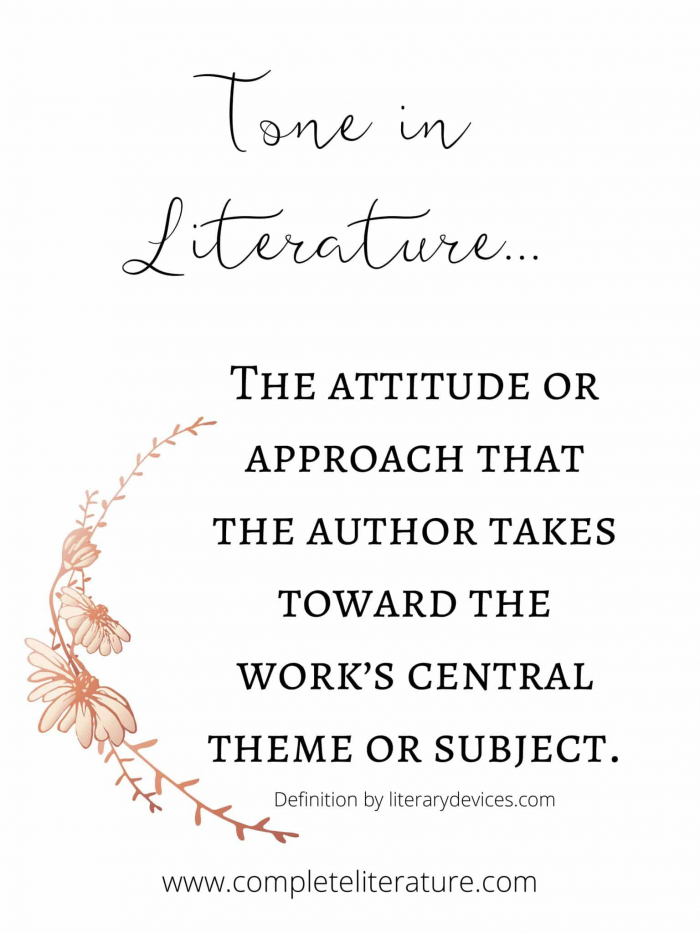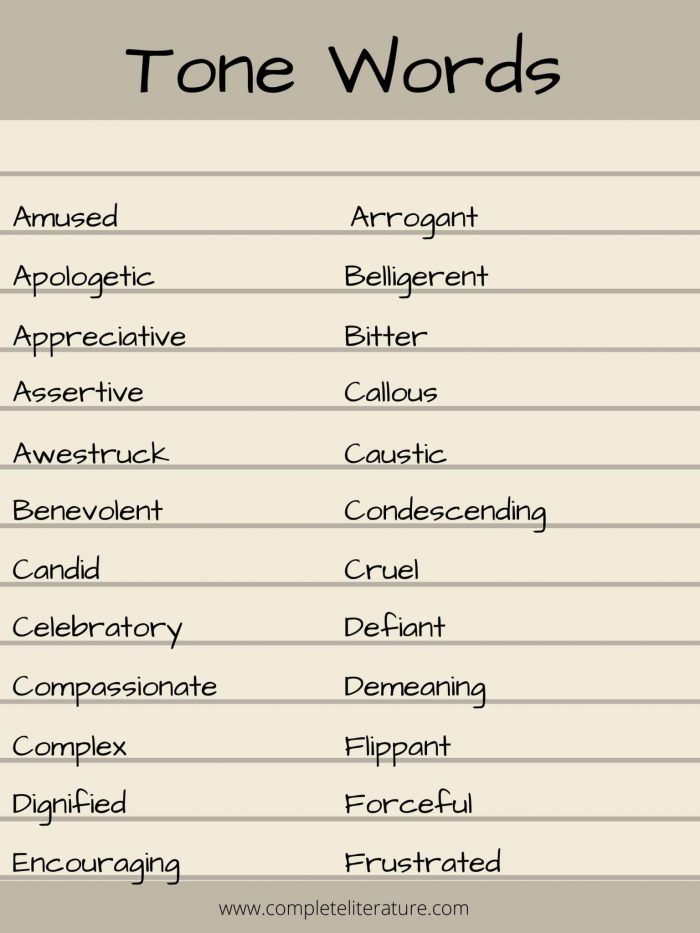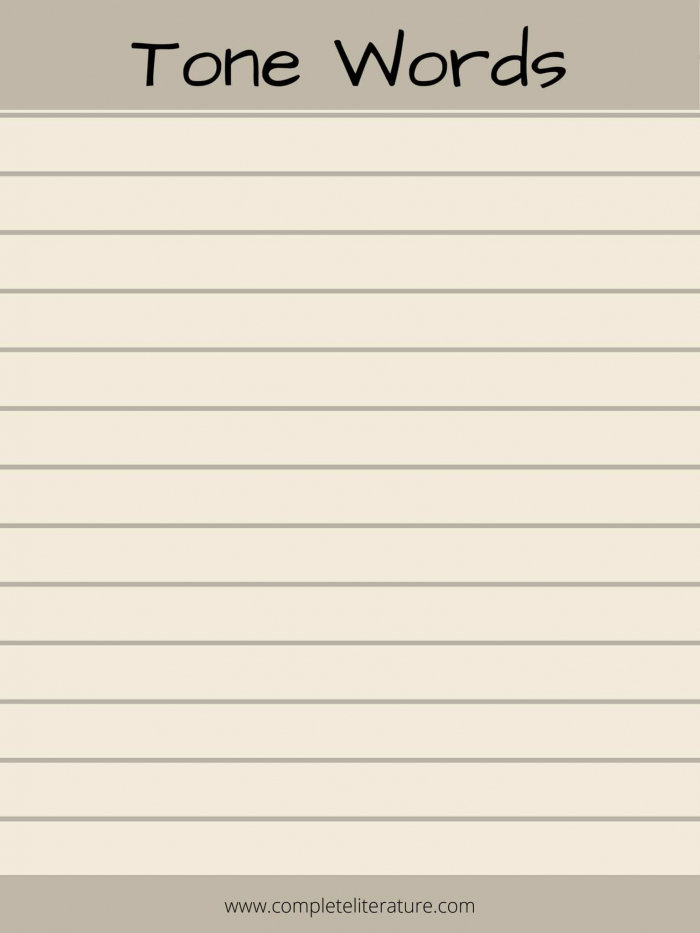Understanding tone in literature is critical to fully understanding and enjoying what you are reading. But because it is not a “tangible” aspect of literature, it is a very hard concept for students to learn.
So how do we effectively teach tone in literature? I spent a good amount of time researching the best ways to teach students concepts of teaching tone in literature that would allow them to comprehend the nuances. And I came up with this list of 10 golden rules for teaching tone in literature: 1. Clearly define tone in literature.2. Give students a foundational list to inspire their ability to identify “tone words.”3. Guide students in pulling out the tone words in a piece of literature.4. Demonstrate how tone can and often does change in literature.5. Show students how the same piece of literature can show very different tones.6. Whenever possible, include physical props to help demonstrate non-physical aspects of tone in literature.7. Have students create their own literature with an emphasis on what they have learned about tone in literature.8. Use a variety of literature genres to allow the students to recognize that tone in literature is universal.9. Start with more obvious tonal cues in literature and work toward the more subtle ones until your students are adept at identifying tone in any passage.10. Make sure students understand the difference between tone and mood in literature.

So now that you have the quick answer, let’s go ahead and unpack exactly what each one of these rules for teaching tone in literature consists of.
Table of Contents
Conclusion
1. Clearly Define Tone in Literature
Every concept we teach must have a clear definition that our students can build a foundation on. In the case of defining tone in literature, students can have a difficult time comprehending exactly what we are teaching. Because of its abstract nature, students who think in terms of “black and white” will have a hard time nailing this one down.We can help make this a more tangible concept for them with a great definition backed up with some great examples.According to literarydevices.com, the definition of tone in literature is the attitude or approach that the author takes toward the work’s central theme or subject.You must be careful that your students do not confuse the author’s attitude or approach for the readers’ thoughts toward the author’s attitude or approach–that is the mood of literature. Giving them some comparisons using a fairly easy piece of literature should help with this. I will also cover it in a bit more detail in Rule #10.Here is a beautiful printable poster that you can print up for your classroom. You can click on it to print it in full poster size or you can fit to page and hand it out to your students to do with as they wish. I think you will find it a great help in teaching tone in literature in your classroom.

2. Give Students a Foundational List to Inspire Their Ability to Identify Tone Words
If you were to make a list of every word that identifies tone, there would not be enough room or time to cover it all. But that is actually a great thing! If you start with a foundational list, you can then add more words to this list on a regular basis with your students. I have provided a printable starting list that you can use to get you started. I also included a blank one for you to add more words with your class.You can print it up as a full size poster or fit to page to make it a worksheet and reference page.


The more you build on this list with your students, the more they will be able to identify them on their own over time. It is awesome when one of the students hears a word and recognizes it as a tone word in a completely random conversation. That’s when we teachers know we have successfully taught the concept!
3. Guide Students in Pulling Out the Tone Words in a Piece of Literature
When teaching tone in literature, I always start with a super easy piece of literature so the concept will be obvious to the students. My usual go-to to introduce the concept is Where the Wild Things Are by Maurice Sendak. It has both tone from the author and so much mood from Max as well as his mom. That makes this not only a great opener for the concept but also a great way to teach the difference between tone and mood.As for the tone aspects, the author shows irritation, excitement, resolve, and restoration. There are many more tones that you can draw out as you get into details.Discussing the events of the book and why Maurice Sendak chose to write about them will help your students pull out lots of different ideas. And it will be easier for them to recognize these tones because it is a book that the vast majority of your students will have read or had read to them many times over.Once your students are easily able to draw the tone of the author from picture books and early reader books, you will be ready to move on to more complex books.Also, helping your students understand that often it is the description of the scene that sets the tone of the reading more than what the characters are saying.
4. Demonstrate How Tone Can and Often Does Change in Literature
There are many reasons that an author’s tone can change in a single piece of literature. It could be to show the reader how an experience totally changed their perspective. Or it could be to surprise the reader. It could be due to wisdom learned over the passage of time. Or it could be just about anything.In fact, tone changes throughout the course of a literary work far more than it stays the same. This is an incredibly important concept to concentrate on when teaching tone in literature.Here is a list of some of the most popular reasons for a change in tone in literature:
The plot becomes more complex.To reflect how current or historical events have changed the world.To take the plot in a more bizarre direction.To show the consequences of something that took place in the book.To show more than one perspective at the same time.
There are almost unlimited reasons for a tonal change in literature. The possibilities are literally as limitless as the author’s imagination.
5. Show Students How the Same Piece of Literature Can Show Very Different Tones
Now that you have shown students why and how literature can have very different tones, it is time to show them some good examples of authors that changed the tone in their work.
The Once and Future King by T.H. White.This book is one of the best books written on the Arthurian legend. It was published in 1958 and continues to be an incredibly popular book. It was directly based on the book Le Morte d’Arthur by Sir Thomas Malory, which was published in 1485. What makes the tone change so drastically throughout is that it was formed from many smaller works that were collected and revised, with new material added in to make it a cohesive work. It was done in a genius manner.
A Little Princess by Frances Hodgson BurnettThis book is another great example. Although when the story begins, we know that life has been somewhat difficult for Sarah because her mother had passed away. In spite of this, her father raises her well and with great love. Because he is wealthy, he is able to send her to the best schools with the best care while he is serving in the military overseas. The tone turns drastically when news reaches Sarah’s headmistress that Sarah’s father has died. She immediately takes away all of Sarah’s privileged life and makes her effectively a poor servant. The tone takes one more drastic turn as Sarah discovers her father is alive and her life returns back to its former glory.Because most books actually have a change in tone as the plot progresses, you will be able to come up with many other great examples that will work perfectly with your students.
6. Whenever Possible, Include Physical Props to Help Demonstrate Non-Physical Aspects of Tone in Literature
Because tone is such a non-tangible concept, this is going to be the hardest of all of the rules when you are teaching tone in literature. But once you have started thinking outside the box it will become much easier to implement.One of the easiest ways to demonstrate this is to recreate a couple of scenes in the book you are studying. To use the example of A Little Princess again, setting up two scenes in your classroom and allowing the students to dress up would beautifully illustrate not only the tones but the stark difference between them.Having a “lavish” school scene or birthday party scene on one side of the class with a sparsely furnished ragged attic scene on the other would allow the students to get a very dramatic picture of the tones. Adding dress up to this will allow them to actually feel the tone.The way to figure this out without a whole lot of difficulty is to set up any scene from any book in your classroom. With some thought and creativity, you can do this with very little if any expense most of the time. I usually just walked around my house looking for things that would resemble the scenes of books that we were reading in class.Once in a while I would look for something at the thrift store if I knew they were likely to have it. And many times I could find the best items at my local dollar store.
7. Use a Variety of Literature Genres to Allow the Students to Recognize That Tone in Literature is Universal
This is pretty straightforward so I don’t need to say much else about it. But I would like to point out some other advantages to this rule besides allowing students to recognize the universality of tone.First, they will experience a wide range of literature. It allow them to read things that they may never have interested them in different circumstances. The good news is that every book ever published has tone, so you will have no shortage of material as you teach tone in literature.Next, they won’t be bored reading the different genres because they will be looking for something in particular–they will be otherwise engaged and not have the chance to be bored with a general reading of the text.And finally, they could very well discover a genre that they never would have realized they have an affinity to. This could turn their reading world in a whole new direction!And there are a couple of advantages to the teacher as well. There is a huge pool of literature you can choose from when you deliberately choose many different genres. And you will be able to please most if not all of your students when you are using that wide variety of genres.
8. Start With More Obvious Tonal Cues and Work Toward More Subtle Tones Until Your Students Become Adept at Identifying Tone in Any Passage
I touched on this concept in rule #3, where I recommended teaching tone in literature by starting with early reader or even picture books.Because the authors of these books understand that early readers do not yet have a good understanding of tone in literature, they tend to exaggerate the feel of tone in order for students and young readers to see it, whether they can name it as tone or not. And that is what makes it so much easier to teach tone in literature to your students by starting with them and working out to more complex books from there.
9. Make Sure Students Understand the Difference Between Tone and Mood in Literature
This is one more issue I touched on briefly in rule #1. It is so easy to confuse tone in literature with mood of the characters. In some ways they can actually be intertwined, especially because the tone of the book is formed many times by what the characters say and do.We have pretty well covered what tone in literature is–it is the author’s attitude or approach as written in his/her literary work.Mood, on the other hand, consists of how you, the reader, feel about what the author has written. Can you both feel the same? Of course. But you can also feel very different from each other based on your perspective.For example, say you are reading a book about an abandoned house in the woods. The author’s tone can be along the lines of peaceful, or he/she could go in the direction of spooky.On the other hand, the reader, based on the peaceful tone of the author, could actually feel the same peace. Or the reader could feel stressed because he/she doesn’t have access to the convenience of the city that he/she is used to living with.Or in the case of the author’s spooky description, the reader can feel fear or terror. Or the reader could feel skepticism.And that realization brings us to the point that mood can be different for different people. This is likely dependent on the experiences that the reader has before reading of the book. Nobody comes to a book with an empty slate. Whatever experiences they have had in life are going to affect how they feel about what they are reading.
10. Have Students Create Their Own Literature With What They Have Learned about Tone in Literature
Now that your students have gotten a good taste of tone in hopefully a great variety of genres of literature, it’s time to branch out and let them try their hand at it.I would work backwards with them and have them set the tones first. Then they could build the scenarios around the tones they had chosen. I would also have them pick 2-3 tones so they could experiment with transitioning between them.This process will almost instantly take their writing skill to the next level. And as you work through it with them, you will love seeing their excitement as they realize how well they can do it on their own!
Conclusion
So these are my 10 Golden Rules for teaching tone in literature. If you follow these rules, your students will not only understand the concept of tone in literature, but will be able to recognize it and create it in their own writing.
If you liked this article, I think you will also enjoy the following articles:
What Makes These 10 Books So Well-loved?The Madeline Hunter Lesson Plan: Should We Still be Using It?